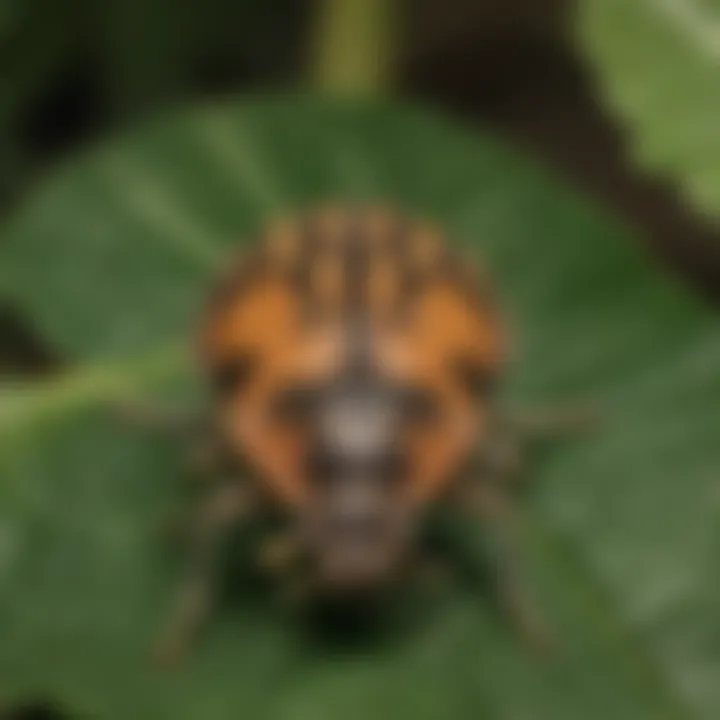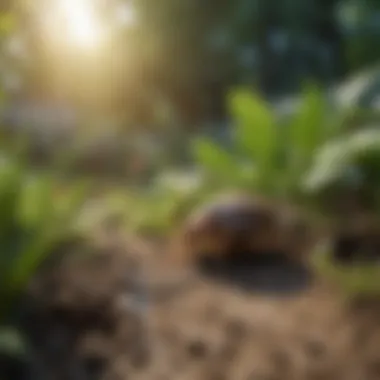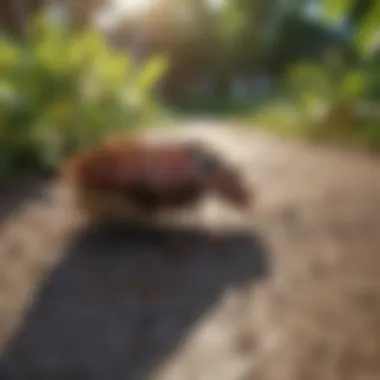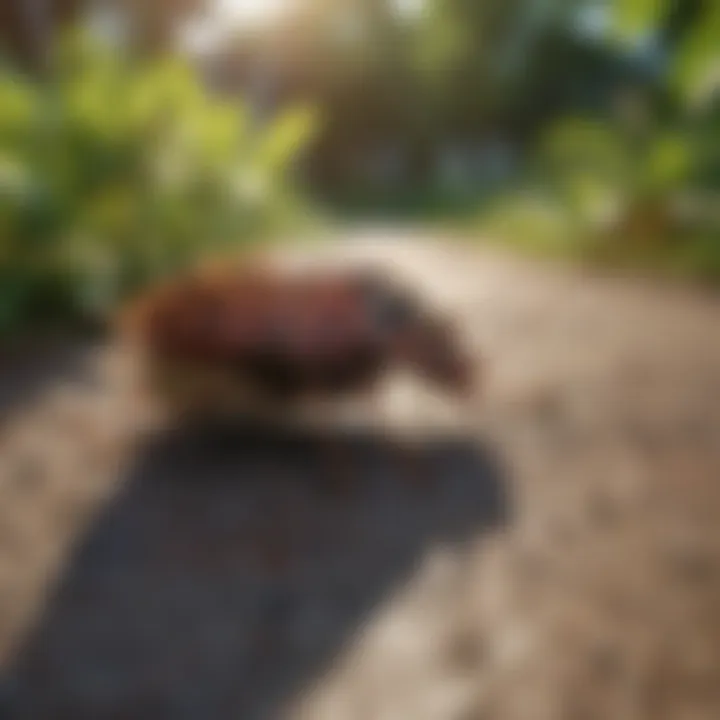Effective Strategies to Deter Stink Bugs in Your Garden


Intro
Gardening is an enjoyable pursuit, bringing beauty and tranquility to many homes. However, the presence of stink bugs can disrupt this peace. Stink bugs are notorious for their foul odor and potential to damage plants. Understanding how to keep these pests at bay is essential for maintaining a healthy garden.
This article aims to provide an in-depth analysis of effective strategies to deter stink bugs. By understanding their habits and learning preventative measures, gardeners can protect their plants more successfully.
Understanding Pests
Definition of Pests
Pests are organisms that cause harm to plants, animals, or humans. They can damage crops, spread diseases, and affect overall plant health. Stink bugs fall into this category as they feed on the sap of various plants, leading to drooping leaves and stunted growth. Understanding what constitutes a pest is the first step in effective garden management.
Importance of Pest Identification
Identifying pests accurately is crucial in developing appropriate strategies to manage them. Stink bugs can be mistaken for other insects, such as beetles or shield bugs.
Proper identification allows for targeted treatments and reduces the risk of harming beneficial insects or the ecosystem.
Understanding their behavior can also help in choosing the right approach to minimize damage.
Prevention Techniques
Home and Garden Preventative Measures
Taking preventive measures is an effective way to keep stink bugs out of your garden. Here are some techniques you can implement:
- Seal entry points: Ensure windows, doors, and other openings are well sealed to prevent stink bugs from entering your home.
- Maintain cleanliness: Keep the garden free of debris. Stink bugs often hide in piles of leaves or clutter.
- Diverse planting: Planting a variety of plants can deter stink bugs. They are less likely to invade a garden that lacks their preferred plants.
Seasonal Prevention Tips
Stink bugs are more active during certain seasons. Here are seasonal tips to manage them:
- Spring: Inspect your garden for early signs of stink bugs. This is when adults emerge.
- Summer: Monitor plants closely. Consider using row covers to protect young plants.
- Fall: Prepare for pest migration to homes. Seal any cracks around your home to minimize intrusions.
Eco-Friendly Pest Control Solutions
Overview of Sustainable Practices
Sustainable practices in pest management can greatly reduce the risks associated with chemical treatments. They emphasize a natural approach that benefits the environment. Some examples include:
- Crop rotation: Regularly changing the location of crops helps disrupt pest lifecycles.
- Companion planting: Certain plants can repel stink bugs, such as basil and marigolds. Integrating these into your garden can deter pests.
Natural Remedies and Their Effectiveness
Natural remedies can provide effective control over stink bugs without harming the environment. While their efficacy may vary, many gardeners have reported success with options such as:
- Diatomaceous earth: Sprinkle this around the garden to create barriers against stink bugs.
- Soap solutions: A mixture of water and mild soap can deter stink bugs if applied directly to them.
By integrating these strategies, gardeners can maintain ecological balance while keeping stink bugs at bay. Understanding their behavior, implementing preventative techniques, and utilizing eco-friendly pest control solutions are key steps in preserving the integrity of your garden.
Understanding Stink Bugs
Understanding stink bugs is crucial for any gardener. These pests can harm plants, reduce crop yields, and spoil the overall enjoyment of a garden. Identifying these bugs correctly allows for precise control measures. Moreover, knowing their biology and habits helps in planning preventive strategies.
Biology of Stink Bugs
Stink bugs belong to the family Pentatomidae. They are characterized by their shield-like shape, which distinguishes them from other insects. Adult stink bugs typically measure between 1/2 to 1 inch in length. Their coloring varies, often appearing green or brown, but some can display vibrant colors. Stink bugs produce a distinct odor when threatened, an adaptation that deters predators. This biologically rooted defense also alerts gardeners to their presence.
Common Species in Gardens
There are several species of stink bugs that commonly invade gardens. The brown marmorated stink bug, for instance, has gained notoriety due to its aggressive feeding habits. The green stink bug is another variant often encountered. Both species target vegetables, fruits, and ornamentals. Familiarizing oneself with these species can significantly aid in prompt identification, thus facilitating earlier intervention in case of an infestation.
Lifecycle and Habits
The lifecycle of stink bugs consists of several stages: egg, nymph, and adult. Females lay eggs in clusters on the underside of leaves. The nymphs hatch and undergo multiple molts before reaching adulthood, which can take about 30 to 60 days depending on environmental conditions.
Stink bugs are most active in warm weather. Their feeding habits can lead to noticeable damage, such as discoloration or deformation in plants. By understanding their lifecycle and habits, gardeners can pinpoint the best times to monitor and act against these pests. Regular inspections during the warmer months can prevent significant infestations and protect garden health.


"Proactive management of stink bugs involves understanding their biology and behavior to implement effective control strategies."
The insights gained from this section lay the foundation for developing effective strategies to keep these pests at bay.
Identifying Stink Bug Infestation
Identifying a stink bug infestation is crucial for maintaining the health of your garden. Early detection is key to minimizing damage and implementing effective strategies to manage these pests. Stink bugs can reproduce rapidly, leading to populations that are difficult to control if they are not addressed promptly. By recognizing the signs of infestation and understanding damage patterns, gardeners can take proactive steps to protect their plants.
Signs of Infestation
There are several signs you can look for to confirm the presence of stink bugs in your garden:
- Visible Stink Bugs: Look for adult stink bugs, typically green or brown, resting on plants or nearby surfaces. They can be found on the underside of leaves or hiding in protective areas, such as crevices or around the bases of plants.
- Eggs: Stink bug eggs are usually found in clusters and resemble small, yellow, or green barrels. Finding these clusters on the leaves indicates that an infestation is developing.
- Damage to Plants: Damage may include yellowing leaves, wilting, or distorted growth. Stink bugs feed by piercing plant tissues and sucking out sap, leading to localized areas of damage on fruits and foliage.
Additionally, smell is a factor. When disturbed, stink bugs release a characteristic odor. If an unusual odor is noticeable around your plants, it may indicate the presence of these pests. Being vigilant and regularly inspecting your garden can help you catch problems early.
Understanding Damage Patterns
Understanding how stink bugs damage plants helps in recognizing an infestation's impact. Here are some common damage patterns:
- Feeding Damage: Stink bugs feed on various parts of the plant, including leaves, stems, and fruits. Their feeding can cause leaf drop, necrosis, and the eventual death of young plants.
- Fruit Damage: When stink bugs feed on fruits, it can cause deformation, discoloration, and even abscission. Commonly affected fruits include tomatoes, peppers, and apples, all of which can suffer significant losses if not monitored.
- Secondary Invaders: Plants stressed by stink bug feeding can become vulnerable to other pests and diseases. A weakened plant is less likely to fend off other threats, leading to a cascading effect of damage.
To conclude, identifying stink bug infestations is not merely about spotting the pests themselves. It involves observing their signs, understanding the resulting damage patterns, and acting accordingly. By doing so, gardeners can effectively protect their gardens from the negative impacts of stink bugs.
Preventive Measures
Preventive measures are crucial in managing stink bugs in your garden. Implementing effective tactics reduces the likelihood of infestation and minimizes damage. A proactive approach can save both time and resources, providing long-term benefits for garden health. This section explores several important aspects of preventive measures, specifically cultural practices, proper plant selection, and enhancing garden hygiene.
Cultural Practices
Cultural practices involve techniques that gardeners can adopt to create an environment less conducive to stink bugs. These methods include crop rotation, intercropping, and reducing or eliminating wet areas that attract these pests. Rotating crops disrupts the life cycle of stink bugs by making it difficult for them to locate their preferred host plants. Intercropping adds diversity to your garden, making it less inviting for pests. It is vital to consider the placement of your plants and keep a varied garden layout.
Moreover, consistent garden maintenance contributes significantly to pest management. Regular weeding prevents stink bugs and their hosts from thriving. Gardeners should also focus on timing their planting correctly to avoid peak pest seasons. This strategic planting can align your crop development with periods of lower stink bug activity, creating a more favorable environment for your plants.
Proper Plant Selection
Choosing the right plants is another significant part of keeping stink bugs at bay. Certain plants are more attractive to stink bugs, while others are less appealing. Selecting resistant varieties or native plants can lessen the chances of infestation. For instance, specific vegetables and flowers are known to attract stink bugs, while others, like marigolds, can deter them.
It is important to research which plants thrive in your area and whether they are prone to insect issues. Maintaining diversity in your garden by planting a mix of varieties can help confuse and deter stink bugs. Additionally, opting for plants that have natural pest-repellent properties can further strengthen your defenses against these pests.
Enhancing Garden Hygiene
Garden hygiene plays a pivotal role in preventing stink bug infestations. Keeping the garden clean and debris-free prevents pests from finding shelter and breeding grounds. Regularly removing fallen leaves, old mulch, and any decaying plant material is essential. It may also be beneficial to clean up areas around the garden, such as patios and pathways, where stink bugs may congregate.
Moreover, consider cleaning any garden tools and equipment routinely. Pests can hitch a ride on tools, moving them from one area to another. This simple habit greatly reduces the risk of introducing new pests into your space. Always check for trapped or hiding stink bugs before storing implements and supplies.
In summary, by adopting these preventive measures, gardeners can effectively create a less hospitable environment for stink bugs. A combination of cultural practices, smart plant selection, and rigorous hygiene maintenance ensures a garden that is healthier, more vibrant, and free from the harmful effects of stink bugs.
"An ounce of prevention is worth a pound of cure."
Utilizing these methods fosters a sustainable garden ecosystem that thrives well beyond any immediate pest concerns.
Natural Repellents
Natural repellents serve as an essential part of any effective strategy to keep stink bugs out of your garden. These methods not only address the problem of pests but also take into account ecological balance. Utilizing natural substances is favored as they are generally safer for both the environment and human health compared to chemical pesticides. Moreover, they reduce the risk of harming beneficial insects like pollinators. Understanding how these repellents work and which options are most effective can make a significant difference in your gardening efforts.
Natural repellents can deter stink bugs by masking the scents that attract them or by providing an unpleasant odor that drives them away. It is important to tailor the approach according to specific circumstances in your garden, such as the type of plants you have and the severity of the infestation.
Essential Oils and Sprays
Essential oils are potent substances derived from plants, known for their strong aromatic properties. Varieties such as peppermint oil, neem oil, and lavender oil can be effective against stink bugs. Studies suggest that these oils disrupt the sensory receptors of stink bugs, making environments less favorable for them.
Applying these oils in a spray form offers versatility in their use. Here’s how to effectively use essential oils:
- Combine with water: Mix a few drops of essential oil with water in a spray bottle. A typical ratio is one tablespoon of essential oil per quart of water.
- Add soap: Including a few drops of dish soap can help break the surface tension, allowing the mixture to adhere better to plant surfaces.
- Frequent application: To maintain effectiveness, sprays should be reapplied every few days, especially after rain.
When using natural oils, consider conducting a small test on a single leaf or plant first. This will ensure that there is no adverse reaction on your plants. This step is crucial, as some plants may be sensitive to certain oils.


Companion Planting Techniques
Companion planting involves placing different plant species together to enhance growth, deter pests, or provide shelter for beneficial insects. This technique not only improves plant health but also reduces the likelihood of stink bug infestations. Certain plants naturally repel these pests or attract their predators.
For effective companion planting against stink bugs, consider these strategies:
- Planting basil or marigold: Both of these plants are known for their ability to repel stink bugs. They emit scents that are undesirable to these pests.
- Utilizing mustard or radish: These can serve as trap crops. By attracting stink bugs away from your prized plants, they can help reduce direct damage.
- Combining species: Grouping plants that have mutual benefits can create a more resilient garden. Be sure to research which combinations yield the best results.
It's beneficial to conduct some planning before planting to maximize synergy and minimize pest attraction. Regularly evaluate your garden layout and adjust as necessary based on observed pest levels and plant health.
"Utilizing natural repellents aligns gardening practices with ecological sustainability, fostering a more harmonious relationship with the environment."
By implementing natural repellents such as essential oils and companion planting techniques, you can cultivate a healthier garden. These methods empower gardeners to manage stink bug populations effectively while maintaining a safe and vibrant ecosystem.
Mechanical Control Methods
Mechanical control methods are an essential part of managing stink bugs in your garden. These methods involve physical means to deter or remove pests without the use of chemical pesticides. They provide safe and effective options for gardeners who wish to minimize their reliance on harmful chemicals. Employing such strategies can enhance plant health and ecological balance in the garden.
Physical Barriers
Physical barriers are one of the simplest and most effective ways to keep stink bugs at bay. These barriers can prevent access to plants, creating a protective space that hinders the entry of these pests. Common options include:
- Floating Row Covers: Lightweight fabric covers placed over plants can protect young seedlings from stink bug invasion. They allow sunlight and water to reach the plants while blocking pests.
- Screens and Netting: Using screens or fine mesh netting around garden beds can stop stink bugs from entering altogether. Ensure that the netting is secured well to prevent any slipping underneath.
- Garden Edging: Installing physical edging around your garden can discourage stink bugs from wandering onto your property. Materials like wood or metal act as a boundary, making it harder for these pests to cross.
Do not forget regular checks of the barriers to ensure they remain intact. Any gaps may create entry points for stink bugs, negating the effectiveness of these methods.
Trap Designs
Trap designs are creative yet functional approaches to managing stink bug populations within gardens. Efficient traps can help minimize infestations and allow for an easier way to monitor pest numbers. Here are a few trap designs that have proven beneficial:
- Homemade Traps: You can create traps using simple materials. For example, use a bowl filled with soapy water placed near affected plants. The soap disrupts the surface tension, causing stink bugs to drown upon contact.
- Commercial Traps: Purchasing commercially available stink bug traps may provide a higher level of efficiency. These often use attractants to lure bugs into a contained area for easy disposal.
- Light Traps: Stink bugs are often drawn to light. Setting up a light source near a shallow container filled with water can attract pests and effectively trap them.
Regular monitoring and strategizing trap placement based on observed stink bug activity can improve their effectiveness.
Mechanical control methods rely on both prevention and containment. Their success not only preserves the quality of your garden but enhances the overall gardening experience without resorting to chemical solutions.
Chemical Control Options
Chemical control methods are a significant aspect of managing stink bugs in your garden. While preventive and natural tactics are effective, sometimes the infestation could be severe. In such cases, chemical solutions may offer immediate and notable impact on reducing stink bug populations. However, it is crucial to utilize these chemicals judiciously, balancing efficacy with safety for both the ecosystem and human health.
Safe Pesticide Use
Using pesticides safely requires careful consideration. First, select pesticides specifically designed for stink bugs. Not all insecticides are equally effective, and some may harm beneficial insects like bees or ladybugs. It is advisable to read labels closely. Look for pesticides labeled "safe for garden use" and those specifically targeting stink bugs.
When applying pesticides:
- Apply during calm weather to avoid drift.
- Follow the manufacturer's instructions precisely.
- Wear protective gear to minimize exposure.
- Avoid spraying during blooming periods to protect pollinators.
Regularly alternating between chemical products can prevent stink bugs from developing resistance. This approach not only enhances effectiveness but also reduces potential long-term impacts on your garden's health.
An informed and cautious approach to pesticide application can help safeguard your plants and the surrounding environment.
Integrated Pest Management Strategies
Integrated Pest Management, or IPM, combines multiple approaches for more effective pest control. It uses a combination of biological, cultural, mechanical, and chemical methods to manage the stink bug population. The goal is to minimize harm to beneficial organisms and avoid chemical over-reliance.
Key elements of IPM include:
- Monitoring - Regular garden inspections help detect stink bugs early, preventing larger problems.
- Threshold Levels - Decide the acceptable number of stink bugs before taking action. If they are below this level, harvest or manual removal might suffice.
- Cultural Practices - Rotate crops and manage planting schedules to disrupt stink bug life cycles.
- Biological Control - Encouraging natural predators, such as spiders or birds, helps control their populations without chemicals.
- Targeted Chemical Use - When necessary, use chemicals only on infected plants and only after all other methods have been tried.
This comprehensive approach can lead to more sustainable gardening practices over time. By emphasizing preventive and integrated measures, you can protect your garden while reducing dependence on harmful chemicals.
Monitoring Techniques
Monitoring techniques are vital steps in the effective management of stink bugs within gardens. These techniques equip gardeners with tools and methods to detect potential infestations early, helping to minimize damage to plants. By establishing a monitoring routine, gardeners can take action swiftly, ensuring a more successful gardening experience.


Regular Inspections
Conducting regular inspections is an essential part of monitoring for stink bugs. Gardeners should set aside time each week to visually check all plants. This includes examining the undersides of leaves and any budding flowers. Look for the bugs themselves, their eggs, and any signs that suggest their presence.
Some indicators of stink bug activity may include:
- Visible bugs in various colors, notably brown or green.
- Egg clusters, which can appear as small, shiny dots.
- Damage patterns on plants, such as wilting or abnormal growth.
Establishing a routine of thorough inspections not only catches stink bugs early but also encourages proactive management. Note that some plants may attract stink bugs due to their natural compounds, so a close monitoring of such plants is critical. Regular inspections, done consistently, can lead to quicker and more effective responses to an infestation.
Using Technology for Monitoring
Technology has significantly changed how gardeners approach pest monitoring. Several tools and apps facilitate monitoring by allowing individuals to track pest activity more efficiently. For example, using smartphone applications can assist in identifying pests and recording their populations over time.
Additionally, garden cameras can provide insights by capturing images of plants and pests around the clock. This can be especially helpful for those who might not have the time to inspect their gardens frequently. Smart traps that connect to mobile devices can alert homeowners when pests are detected, allowing for immediate action to be taken.
Incorporating technology not only makes monitoring more effective but also encourages data-driven decisions for pest management. By understanding when and where stink bugs are active, one can adjust preventive measures accordingly.
Regular monitoring, both through physical inspections and technology, forms the backbone of an effective pest management strategy against stink bugs.
Adapting to Environmental Changes
Adapting to the shifts in environmental conditions is critical when managing stink bug populations in your garden. These pests thrive under specific climates and changing weather patterns can either exacerbate their presence or assist in controlling their spread. Understanding how these environmental elements interact with the behavior and lifecycle of stink bugs allows gardeners to develop effective strategies against infestations.
Understanding Climate Impact
Climate plays a significant role in stink bug activity. Warmer temperatures can lead to earlier emergence in spring and a prolonged growing season, creating optimal conditions for reproduction. Consequentially, high populations may emerge in gardens during these warmer months. It is important to monitor local climate trends, as they may inform you about potential peaks in stink bug activity. A few steps to consider include:
- Stay informed: Be aware of the seasonal changes in your area and how extreme weather events may affect pest patterns.
- Microclimates: Create microclimates within your garden that can potentially deter stink bugs. For example, shaded areas can provide some resistance during hot periods.
- Seasonal adjustments: Adjust planting schedules based on climate predictions, which could help minimize pest impact.
Alteration of Stink Bug Behavior
Behavioral adaptations of stink bugs are influenced by environmental changes. For instance, shifts in temperature and humidity can affect their feeding and mating habits. Recognizing these changes can aid in developing responsive measures to mitigate the impacts on your garden.
It is important to observe the behavior of stink bugs throughout different seasons. Here are key aspects to consider:
- Feeding patterns: Monitor how feeding activities might change with temperature variations. Stink bugs tend to feed more aggressively during fluctuating weather, so vigilance is essential.
- Mating cycles: Warmer winters may enable stink bugs to survive longer and reproduce at greater rates. Therefore, promoting natural predators or creating environments unfavorable for mating may reduce populations.
- Foraging behavior: Understanding when stink bugs are most likely to enter your garden can help in strategizing your defenses effectively.
"Keeping an eye on environmental shifts empowers you to anticipate stink bug behavior, allowing for timely intervention in your gardening practices."
Overall, adapting to environmental changes takes foresight and adaptability. Rather than solely relying on static methods, gardeners must evaluate how every season's unique challenges can be used to shape their strategies. Building resilience towards these pests not only preserves your garden’s health but also enhances your connection to nature's patterns.
Community Actions and Resources
Working with Neighbors
Collaboration with neighbors can lead to a unified approach in pest management. Here are some key elements to consider:
- Communication: Start by discussing the problem with nearby gardeners. Sharing experiences can help identify the pest’s arrival and spread quickly.
- Joint Efforts: Plan community cleanup days to remove potential stink bug habitats such as unkempt gardens and debris. This eradicates possible breeding grounds.
- Shared Resources: Pool funds to buy effective repellents and traps in bulk, reducing individual costs while enhancing collective protection on a larger scale.
- Coordinated Timing: Plan planting and harvesting schedules together. This can help mitigate the impact of stink bugs during peak season. If everyone adopts similar strategies, the pests may have a harder time finding food sources.
Educational Resources
To combat stink bugs effectively, it is essential to empower yourself and your neighbors with knowledge. Here are some educational resources that can be beneficial:
- Local Cooperative Extensions: Many universities offer free resources on pest management. Look for extension services in your region for tailored advice relevant to local conditions.
- Online Forums: Websites like Reddit and Facebook have groups dedicated to gardening where individuals share experiences and solutions regarding pest control. Engaging in these communities can lead to innovative ideas and shared strategies.
- Workshops and Seminars: Attend community workshops on pest management. These sessions often include practical demonstrations and Q&A with experts who can address specific concerns.
- Informational Guides: Utilize resources from reputable sources, such as encyclopedias and gardening websites, to develop a deeper understanding of stink bugs and effective control methods.
"An informed gardener is a powerful gardener. Knowledge shared in a community enhances resilience against pests like stink bugs."
By integrating community actions and utilizing educational resources, homeowners can create a comprehensive framework to protect their gardens from stink bugs. The shared endeavor not only empowers gardeners but also fosters community spirit.
End
In summarizing the core points of this article, we recognize that managing stink bugs in gardens is not just a matter of applying quick fixes. It involves a multifaceted approach that encompasses prevention, identification, and long-term strategies. By understanding the biology and habits of stink bugs, gardeners can implement targeted actions to keep these pests at bay, protecting the overall health of their plants.
Effective Strategies Recap
- Preventive Measures: Enhance your garden's defenses by adopting cultural practices, selecting appropriate plants, and maintaining a clean environment. These measures create an unfavorable habitat for stink bugs, significantly reducing infestations.
- Natural Repellents: Employ essential oils and utilize companion planting techniques to deter the presence of stink bugs naturally.
- Mechanical Control: Implement physical barriers and innovative trap designs to capture and eliminate stink bugs before they cause harm.
- Chemical Control: When necessary, use safe pesticides effectively while integrating these within a broader pest management strategy.
- Monitoring Techniques: Regular inspections and modern monitoring technologies can provide crucial early warnings of pest activities.
- Community Actions: Collaborate with neighbors for a unified approach against stink bugs, and make use of educational resources for better knowledge and practices.
Encouragement for Sustainable Practices
Encouraging sustainable practices in the fight against stink bugs involves more than just individual actions. It is about fostering a community-wide understanding of pest management that prioritizes ecological health. As you apply these methods in your garden, consider spreading awareness among neighbors and friends. Perform garden workshops or share information on social media platforms, like Facebook or Reddit, to help others become informed. By advocating for organic methods and reducing reliance on harmful chemicals, you contribute to a healthier environment.
Remember, the goal is not only to eliminate pests but also to maintain a balanced ecosystem conducive to the growth of healthy plants. Through these sustained efforts, you can enjoy a thriving garden while minimizing the impact of stink bugs.



